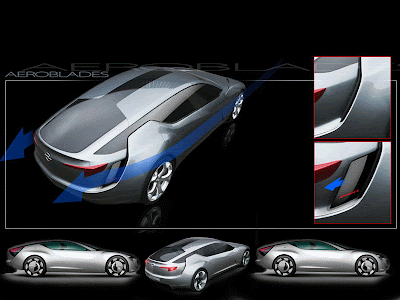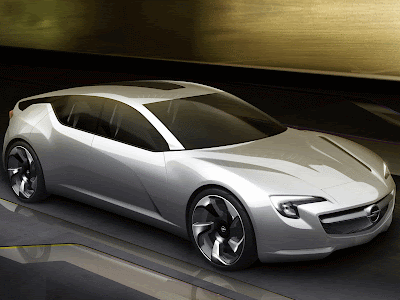Showing posts with label Opel. Show all posts
Showing posts with label Opel. Show all posts
Friday, March 11, 2011
2011 Opel Corsa, this car has been updated years ago, and now updated exterior and interior design and joined the initial & stop. Exercises done in the style of Opel Corsa 2011 alter the easiest element to change without any obligation to unreasonable costs.
Thus, the work of the bumper and grill in betting on the new Corsa for greater joy and sportsmanship, as shown by the chrome strip that includes the new Opel logo and plastic racks to cool the motor. Additionally, the headlamps now incorporate the contents of a boomerang-shaped crown entities. They are also changing in ways that embrace the fog and new colors are added to make the various -15 Opel Corsa 2011.
Interior Opel Corsa is also updated with fun colors and visual effects in trim panels and dashboard. Elsistema Touch Connect also emphasizes multimedia infotainment and color touch-screen navigation welcomed five inches in 28 countries with iPod jack, and USB, Bluetooth ...
As recent developments included in the range of the ceiling laversión Opel Corsa Color Edition and a black painted wheels associated with bright colors and plenty of extras. Also new is the line pack that allows you to decorate with two big bands on the Opel Corsa's body from the tent to the gate, conjoined with a mirror in the same key.
Start & stop reaching Opel Corsa Diesel 1.3 CDTi especially 75 and 90 hp. Announced the reduction of consumption to 4.2 l/100km city compared with the 4.6 engine without this element. The average consumption is 3.5 liter, 94 g / km of CO2. The remaining mechanics remained unchanged compared with the last update that took place last year.
Range of power in the Corsa moving from the engine 65 hp to 192 hp 1.0 OPC seven mechanical possibilities. 75-130 hp motor diesel is associated with 1.3 and 1.7 CDTi. In the chapter about the price, the official rate muevenentre € 12,215 Opel Corsa 1.0 Essentia 3 door with 65 hp and costs € 23,850 Opel Astra OPC's 192 hp.
again start & stop for 75 hp motor costs € 15,710 in the three-door and 16,220 for the hatchback. In the case of Opel Corsa CDTi 90 hp with the elements to optimize consumption, costs € 15,950 three-door and five door up to € 16,710.
Thus, the work of the bumper and grill in betting on the new Corsa for greater joy and sportsmanship, as shown by the chrome strip that includes the new Opel logo and plastic racks to cool the motor. Additionally, the headlamps now incorporate the contents of a boomerang-shaped crown entities. They are also changing in ways that embrace the fog and new colors are added to make the various -15 Opel Corsa 2011.
Interior Opel Corsa is also updated with fun colors and visual effects in trim panels and dashboard. Elsistema Touch Connect also emphasizes multimedia infotainment and color touch-screen navigation welcomed five inches in 28 countries with iPod jack, and USB, Bluetooth ...
As recent developments included in the range of the ceiling laversión Opel Corsa Color Edition and a black painted wheels associated with bright colors and plenty of extras. Also new is the line pack that allows you to decorate with two big bands on the Opel Corsa's body from the tent to the gate, conjoined with a mirror in the same key.
Start & stop reaching Opel Corsa Diesel 1.3 CDTi especially 75 and 90 hp. Announced the reduction of consumption to 4.2 l/100km city compared with the 4.6 engine without this element. The average consumption is 3.5 liter, 94 g / km of CO2. The remaining mechanics remained unchanged compared with the last update that took place last year.
Range of power in the Corsa moving from the engine 65 hp to 192 hp 1.0 OPC seven mechanical possibilities. 75-130 hp motor diesel is associated with 1.3 and 1.7 CDTi. In the chapter about the price, the official rate muevenentre € 12,215 Opel Corsa 1.0 Essentia 3 door with 65 hp and costs € 23,850 Opel Astra OPC's 192 hp.
again start & stop for 75 hp motor costs € 15,710 in the three-door and 16,220 for the hatchback. In the case of Opel Corsa CDTi 90 hp with the elements to optimize consumption, costs € 15,950 three-door and five door up to € 16,710.
Labels: Opel
Friday, December 3, 2010
Opel Amphibian Sport Cars Icona Concept
The Opel Icona Concept Cars is a design study of a futuristic amphibian electric vehicle with a sporty design and retracteable wheels. Keeping such scenario in mind, Swedish designer Juan Pablo Bernal P has designed a futuristic vehicle for the year 2050 that moves on both land and water with equal efficiency. Called the “OPEL ICONA,” the V-shaped commuter vehicle features an aerodynamic body to ensure minimal air resistance for better performance in all conditions. The V shaped dynamic design uses distinctive shapes, forms, patterns and proportions which are express the sporty and leisure-oriented character of the vehicle.Running on natural sources of energy, the all-electric vehicle generates power from electric motors to allow a clean and green drive. The zero-emission car would not only allow a sustainable drive but also become a means of entertainment to create a special bond between the family members as well as society.
The Opel Amphibian Sport Cars Icona Concept is a hybrid car that can traverse land and sea is nothing new despite being the stuff of dreams at least half a century ago, but this concept cars takes things to a whole new level. It can transport an adult and a child. The Opel Icona project was developed in collaboration with Opel by Juan Pablo Bernal at the Umea Institute of Design, Sweden.
Juan Pablo Bernal is Colombian Designer with a Bachelor in Transportation Design from Instituto Europeo di Design (2003-2006) and a MA Degree in Transportation Design from Umea institute of Design in Sweden.
Among his working experiences are internship at the GM Europe Design and at Scania, Sweden.
 Opel Amphibian Sport Cars Icona Concept
Opel Amphibian Sport Cars Icona Concept
Monday, September 6, 2010
The Opel Insignia is a large family car engineered and Produced by Opel, the Germany subsidiary of General Motors (GM) since 2008, replacing the Opel Vectra. Launched at the 2008 British International Motor Show in London as the Vauxhall Insignia, the United Kingdom market name, the Opel Insignia name is Used throughout continental Europe and Ireland, with Chinese-market Buick Regal badged versions.
The Buick Regal Will Also be available in North America from late 2010. In Chile, the Insignia will of retaining the name as the Chevrolet Vectra Used by the previous Vectra models. Also Insignia is the first production car to feature a dual-function frontal camera with traffic sign recognition. The Insignia was voted 2009 European Car of the Year.
From launch, the Insignia offered a 6.1 liter straight-four Family 1 engine producing 85 kilowatts (116 PS, 114 hp), a 1.8 liter version producing 103 kilowatts (138 hp), a 2.0 liter straight-four Family II turbocharged direct injection petrol producing 162 kilowatts (217 hp), a Holden-built 2.8 liter High Feature V6 turbo petrol engine producing 191 kilowatts (256 hp), and three turbocharged 2.0 liter "CDTi" straight-four diesel engines, producing 81 kilowatts (109 hp), 96 kilowatts (129 hp) and 118 kilowatts (158 hp). These CDTi diesels are derived from the Fiat / Opel JTD engines.
The engine lineup was expanded in early-mid 2009 with a 6.1 liter petrol turbo producing 132 kilowatts (177 hp) as well as a fourth variation to the 2.0 liter "CDTi" diesel, producing 140 kilowatts (190 hp) in a twin-turbo form . The Latter, engine code A20DTR, has been delayed Until at least 2011, axles Saab, WHO produces the unit in its TTiD models is now no longer part of GM.
[Citation needed] All nine engines meet Euro 5 emissions standards, and all are offered with in front-wheel drive configuration; Exceptions are the 2.8 petrol turbo and 2.0 liter twin-turbo diesel Which are offered with Saab XWD all-wheel drive by default. With the 2.0 liter turbo, both forms are available Propulsion. Six-speed manual or automatic transmissions are fitted throughout the range, although the five-speed Automatics Are Used on the 1.6 and 1.8 liter petrol engines as well as the base diesel.
Specification
Opel Insignia 1.6 Turbo ECOTEC
Wheelbase 2737 mm 107.8 in
Track front 1585 mm 62.4 in
rear 1587 mm 62.5 in
Length 4830 mm 190.2 in
Width 1858 mm 73.1 in
Height 1498 mm 59 in
Length:wheelbase ratio 1.76
Ground clearance
Kerb weight
Weight distribution
(Front)
Fuel capacity 70 litres 15.4 UK Gal 18.5 US Gal
aerodynamics
2009 Opel Insignia 1.6 Turbo ECOTEC
Drag coefficient 0.270
Frontal area
Cx
engine
Opel Insignia 1.6 Turbo ECOTEC
Bore × stroke 79.00 mm × 81.50 mm
3.11 in × 3.21 in
Cylinders S-4
Displacement 1.6 litre
1598 cc
(97.516 cu in)
Type DOHC
4 valves per cylinder
16 valves in total
Construction
Sump Wet sumped
Compression ratio 8.80:1
Fuel system EFI
Maximum power 180 PS (177.5 bhp) (132.4 kW)
@ 5500 rpm
Specific output 111.1 bhp/litre
1.82 bhp/cu in
Maximum torque 230.0 Nm (170 ft·lb) (23.5 kgm)
@ 2200-5500 rpm
bmep 1808.7 kPa (262.3 psi)
Specific torque 143.93 Nm/litre
Maximum rpm
Manufacturer Opel
Code
Main bearings 5
Coolant Water
Bore/stroke ratio 0.97
Unitary capacity 399.5 cc/cylinder
Aspiration Turbo
Compressor type
Intercooler
Catalytic converter Y
0-50 mph (80 km/h)
0-60 mph
0-100 km/h 8.90 s
0-100 mph
80-120 km/h (50-70 mph) in top
Standing ¼mile
Standing km
Top speed 225 km/h (140 mph)
Fuel consumption 10.7/6.0/7.7 l/100km urban/extra-urban/combined
CO2 Emissions 181.0 g/km
Carfolio Calculated CO2 ?
Power-to-weight
chassis
2009 Opel Insignia 1.6 Turbo ECOTEC See all Opel models
Engine location Front
Engine alignment Transverse
Drive FWD
Turns lock-to-lock
Turning circle
Suspension front
rear
Wheels front
rear
Tyres front 225/55 R 17 W
rear 225/55 R 17 W
Brakes F/R VeDi/Di-S-ABS
Key: VeVentilated DiDisc (Disk) DrDrum SServo-assisted ABSAnti-lock Braking System
Brake ∅ front
rear
Braked area
Transmission 6 speed manual
Top gear ratio
Final drive ratio
general
2009 Opel Insignia 1.6 Turbo ECOTEC See all Opel models
RAC rating 15.5
Number made
Model code
Model family
Insurance classification No information available
Tax band No information available
2009 Opel Insignia 1.6 Turbo ECOTEC added 2009-03-19.
Last modified 2009-09-30.
Labels: Opel
Sunday, July 11, 2010
Opel performed the world debut of its first Compressed Natural Gas compact van with a turbocharger, the Zafira ecoM, at the Bologna motor show. This particular variant of Opel's 7-seater minivan is equipped with a 1.6-liter turbo engine designed to run on either natural gas, bio-methane or any mixture of the two. The unit is provided with special pistons, valves and valve seats, plus separate injection systems for natural gas and gasoline. The engine has an output of 150HP offering the Zafira a top speed of 200 km/h (124 mph) and an average consumption of 5.3 kg of natural gas per 100 km in the MVEG cycle, emitting 144 g/km of CO2.
In gas mode alone, the vehicle can drive up to 370 km (230 miles), while the 14-liter reserve gasoline tank provides an additional range of 150 km (93 miles) for maximum flexibility. Zafira advantage in terms of flexibility and spaciousness are not disturbed in any way, influenced clever underfloor arrangement of four gas tanks around the rear axle. In fact, natural gas vans to give the space even more compact than its predecessor and has a luggage compartment capacity of 645 liters in the five-seat configuration - the largest among the seven-seat compact vans (depending on seating configuration up to a maximum of 1820 liters). As successful predecessor, the Zafira 1.6 CNG has a feature "innovative monovalentplus" concept, allowing maximum efficiency with natural gas operation. Sales of second-generation Zafira CNG start in spring 2006, while orders can be placed mid-September, when prices are announced.
Optimized high security, high-strength steel gas tank and rust free stainless steel pipe-gas safely outside the impact zone. This was also confirmed by ADAC in crash tests conducted by the first Zafira CNG in the spring of 2005. "The tank of gas that is stored in metal containers remain in their original position during both frontal and side collisions, despite body deformation. They therefore optimally protected against damage. The entire gas system stayed tightly closed, also the result of a safety valve that automatically shut in the tank ", said the club car experts, concluded the test results. In addition, the results clearly showed that the risk of fire with natural gas vehicles are not higher than usual. This is also due to the fact that natural gas is much less flammable than gasoline, and in case of a leak is highly unlikely, it soon disappeared. The new Zafira CNG also features the SAFETEC efficient system integrated into the passenger cell, which are reinforced by metal plates ultra-high strength. This ensures Zafira highest rating of five stars for adult passenger safety in Euro NCAP crash investigation.
With its innovative concept, CNG unit has a compression ratio increased, allowing high efficiency, and designed for optimal operation with natural gas, biogas or a mixture of both. Machine has special pistons, valves and valve-seat insert, and a separate injection banks for natural gas and gasoline. In addition, the engine management system optimized for natural gas operation. A 14-liter tank of gas reserves ensures continued mobility on routes without a natural gas filling stations. Switching between operating modes of fuel is through a button on the center console, or happens automatically when the main fuel supply was too low. Thanks to low consumption and low capacity of four natural gas tank 'of 21 kilograms, the Zafira CNG has a total operating range of more than 540 kilometers.
Labels: Opel
Thursday, July 8, 2010
Did the papers have something significant to them about the car or do they just use them to block our view?
That is the head designer Marc van der Haegen Astra and Laszlo Kreth, technical coordinator at the new Astra project, doing the best strip tease to show the next generation model.
Opel will offer a version of the body's upcoming Astra several styles, including three-door hatch, which inspired the name of the GTC coupe, four-door sedan, wagon, coupe / convertible and, of course, the standard five-door hatch.
Opel designers and engineers believe quality execution also must be matched by what the customer sees and feels. Such perceptual quality is particularly important in the interior, where the appearance and tactile properties of all materials must be on a par with their high standard of fit and finish.
The quality of the materials used in the new Astra is evident in such things as the grained, soft-touch surfaces, the textured panels, the quality of the décor, the chrome trim elements, and the feel of operating buttons and switches.
Quality in execution, quality in the materials used and quality as perceived by the customer add up to the new Opel Astra’s upscale appearance. Together they deliver the sculptural artistry and German precision of Opel’s new design language.
New Astra is based on the same architecture with the Chevy Volt, but it will not come as a plug-in or hybrid standards, at least not at first. New will be a / 1.4-liter, turbocharged gasoline engine with various power output of gasoline. A streamlining of the first initiated by VW with a 1.4-liter turbo engine itself, with many cars in Europe are now offering a turbocharged 1.4-liter or a 1.6 naturally aspirated powerplants instead of 2.0 liters.
Opel implants will most likely be booked for 2.0-liter version of OPC (or VRX for Vauxhall Astra) to rival the Golf GTI and other hot hatch, the engine is currently available in 240 hp turbo configuration.
Labels: Opel
Thursday, June 10, 2010
The new Opel Astra GSi will be unveiled in October at the Paris Auto Show and will go on sale later this year or early in 2011. The 2011 Opel Astra GSi will feature various new design elements, including a re-styled front bumper, new wheel arches, a small rear diffuser and double exhaust pipes.

2011 New Opel Astra GSI Concept Cars Third Millennium
Opel fans al already asking when will the new Astra GSI will make its debut. Today we have the answer for them: the new 2011 Opel Astra GSI will make its debut this autumn at the Paris Motor Show, according to the latest reports from Auto Motor und Sport.
The new Opel Astra GSi 5-door layout back to talk about himself, with eloquent spy photos. The famous symbol will return to sport compact Russelsheim later this year. In fact, the Astra GSi will officially introduce yourself to October at the Paris Motor Show and will be sharing the catwalk in Paris with the new Sports Cars Tourer estate.

The new vehicle will carry, as expected, a 2.0-liter Turbo engine which will deliver around 190 hp… we do hope that this will get at least 200 hp in order to take on the Vw Golf GTI. Regarding the OPC version this will carry over 240 hp. The new Astra GSI will also come with a new body kit which will include wider wheel arches, a new front and rear bumper, new side sills, dual exhaust pipes and a dual-tone interior with Recaro sport buckets. Most sources say the 2011 Opel Astra GSi will only be available in the 5 door body style. The 3 door will be sold only as a OPC / GTC.

The new Opel Astra GSi be the top version of the variant 5-door, while the symbol OPC will be given only to the three-door GTC. The 2011 New Opel Astra GSi third millennium will be equipped with the 2.0 Turbo petrol engine, whose maximum should be around 190-200 horses. The Astra OPC boasts a 2.0-litre turbocharged motor with 177kW. The GSI should feature about 140kW or so.

The sports chassis will be recognizable to the wider wheel arches and front bumper changed. At the rear, as well as the letters GSi, Opel Astra in this version will be distinguished for the double exhaust. Even in the cockpit there are specific characterizations, such as two-tone sport seats.
The Astra GSi price will be announced at a later date.
Labels: 2011, Concept Car, Opel
Thursday, March 4, 2010
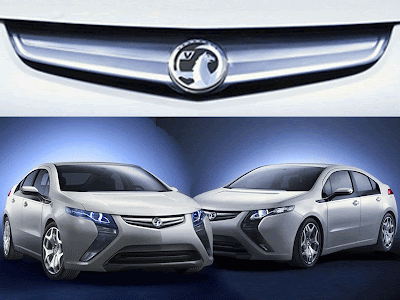
The most enlightening spy photos of the production version of the 2011 Opel Ampera plopped in our inbox today. At first we thought it was just the concept model out testing, but a closer look at the completely undisguised Ampera with the German license plates revealed that this is the actual production model that's due to go on sale in Europe and the UK (as a Vauxhall) in late 2011.

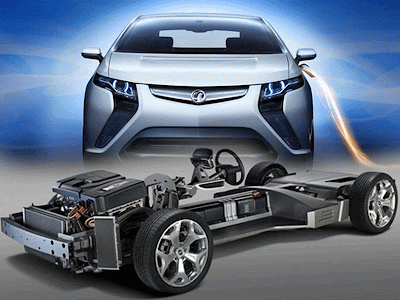
2011 Opel Vauxhall Ampera Plug-in Hybrid
Vauxhall Ampera will be unveiled along with Vauxhall Meriva compact MPV at the Geneva Motor Show 2010. Vauxhall Ampera, schedule for production late next year, is a five-door four-seater with same design DNA as Astra and the Car of the year-winning Insignia. Ampera uses extended-range electric vehicle (E-REV) technology. E-REV uses electricity as its primary power source, supplemented by a small engine to generate electricity for its motors when electric power runs low. This helps the Ampera overcome the ‘range anxiety’ issues associated with pure electric cars.
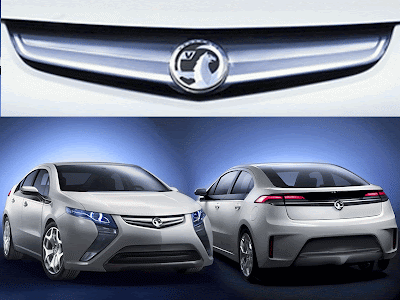
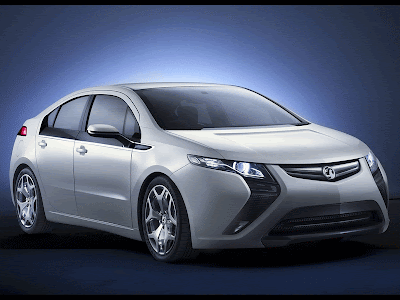
2011 Opel Vauxhall Ampera Plug-in Hybrid
Unlike other conventional propulsion systems, E-REV uses electricity as its primary power source, supplemented by a small engine to generate electricity for its motors when electric power runs low. This helps the Ampera overcome the ‘range anxiety’ issues associated with pure electric cars. Vauxhall will unveil not one, but two cars at this year’s Geneva Motor Show on March 2, with world premieres of the all-new Meriva compact MPV and a futuristic concept car, which is set to boost the company’s credentials as a leader in environmental vehicles.
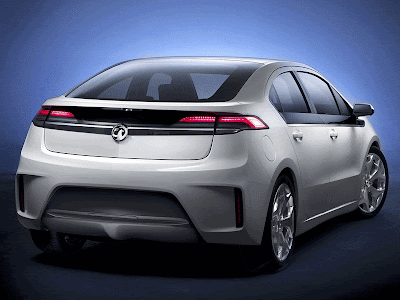
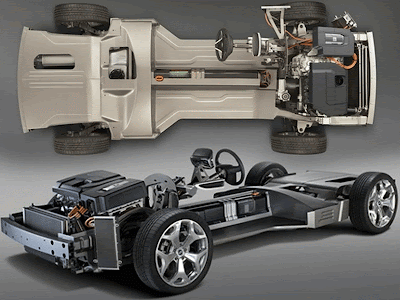
2011 Opel Vauxhall Ampera Plug-in Hybrid
A quick recap of the details we already know, the Ampera will use the same plug-in hybrid gasoline-electric drivetrain as the Volt. It mates a powerful electric motor and a 16-kWh, lithium-ion battery pack to a 75HP 1.4-liter gasoline engine. But unlike conventional hybrids that use gasoline engines to power the wheels when the battery is depleted, the Ampera uses the petrol unit to generate electricity for the electric motor that always drives the (front) wheels. Owners will be able to charge the battery pack with a home outlet and drive for about 64km or 40 miles before the gasoline engine-generator kicks in to extend the Ampera's range to more than to more than 300 miles or 480 kilometers.
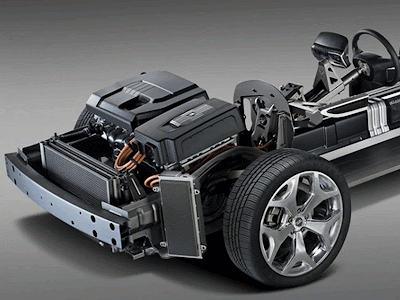
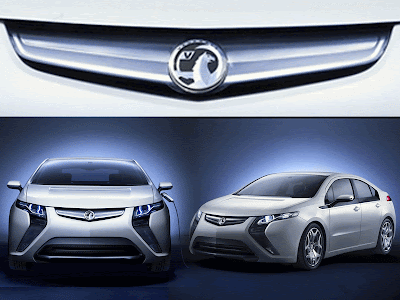
2011 Opel Vauxhall Ampera Plug-in Hybrid
Bolstering this message still further at the show will be the groundbreaking Ampera extended-range electric vehicle and Vauxhall’s most economical production car to date, the latest Corsa ecoFLEX.
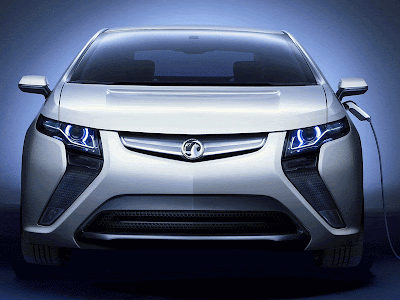
2011 Opel Vauxhall Ampera Plug-in Hybrid
‘Vauxhall is covering all bases at Geneva,’ said Duncan Aldred, Vauxhall’s Managing Director. ‘With the Meriva, we have a unique and innovative take on family motoring, but the concept car and Ampera prove that we are truly at the forefront of environmental technology. These vehicles also show that their versatility and efficiency doesn’t come at the expense of stunning design.’
Labels: 2011, Concept Car, Opel, Sports Car
Saturday, February 27, 2010
Think of the Opel Flextreme GT/E concept as a bigger Chevrolet Volt (or Opel Ampera if you're European). The idea behind this concept, which will debut at the Geneva Motor Show (March 4 - 14, 2010), is to show how the Volt's extended-range electric vehicle drivetrain can be used in a larger vehicle, in this case a mid-size five-door hatchback. And it will boost the company's credentials as a leader in green technologies, offering expressive design with efficient environmental performance - and engineered with German precision.
2010 Opel Flextreme GT/E Concept with E-REV Drive System
In Opel's strategy for achieving more independence from fossil fuels, electricity plays a key role. The 4.7-meter long Opel Flextreme GT/E Concept illustrates how extended-range electric vehicle (E-REV) technology can be plugged into large or mid-size vehicles, as well as compact cars such as the upcoming Opel Ampera. Opel calls this strategy e-mobility unlimited: adapting the highly efficient E-REV drive system - which removes the limitations of battery-only power - to vehicles across all market segments. To enjoy zero CO2 driving emissions Opel-style, the Flextreme GT/E concept shows that size doesn't matter.
2010 Opel Flextreme GT/E Concept with E-REV Drive System
The purposeful design also enables the Opel Flextreme GT/E Concept to achieve a projected drag co-efficient of just 0.22, which helps it reach a 200 km/h-plus top speed as well as conserve energy and extend its driving range. Stand-out visual features include a low and wide stance, wing-shaped lights front and rear, a distinctive nose and grille, floating C-pillars and muscular, sculptured bodywork.
2010 Opel Flextreme GT/E Concept with E-REV Drive System
The clean, frontal styling features a low hood line and an extended nose section, which is clasped by wing-shaped, signature LED headlamps. These are deeply carved into the front fenders and across the hood line. The new trapezoidal grille execution is slim but bold. The prominent wing-shaped chrome bar carries a large Opel emblem, which doubles as a socket for charging the Opel Flextreme GT/E Concept's battery pack. The upper section of the grille is used to admit cooling air, the lower portion being covered by a translucent panel. The absence of additional air intakes allows a low frontal area for aerodynamic efficiency and also enables the Opel Flextreme GT/E Concept to meet future pedestrian protection requirements.
2010 Opel Flextreme GT/E Concept with E-REV Drive System
In profile, the Opel Flextreme GT/E Concept is distinguished by innovative, stubbed C-pillars. This floating design allows the glasshouse to be extended rearwards under the arching roofline, emphasizing the flowing lines of the side body. The car's dynamic character is further underlined by a fresh expression of Opel's signature blade motif, now a swooping swage line from the base of the C-pillar into the lower front fender. The translucency of the fixed glass panel in the center of the roof is adaptive, allowing sunlight to warm the interior in the cold of winter, but darkening for coolness in summer. A duct at the rear edge of the roof is for additional cooling of the battery and electronic components.
2010 Opel Flextreme GT/E Concept with E-REV Drive System
Integral to the Opel Flextreme GT/E Concept's expressive looks is the efficiency of the design execution. The small frontal area, low roof height (1308 mm) and a flat, enclosed underbody all enable the car to cleave the air with a minimum of disturbance. The 21-inch alloy wheels are relatively narrow, to reduce wind resistance, and fitted with 195/45, low rolling resistance tires. Clear, flush-mounted trim inserts also minimize air turbulence.
2010 Opel Flextreme GT/E Concept with E-REV Drive System
The Opel Flextreme GT/E Concept also explores the potential for active shape shifting. At speeds above 50 km/h, a vertical panel extends along the body from the air extraction slot behind each rear wheel-arch. These 350 mm-long side spoilers guide high-speed airflow around the rear corners of the car, further reducing the amount of turbulence.
2010 Opel Flextreme GT/E Concept with E-REV Drive System
Mass reduction measures for the body include the use of lightweight, carbon composite outer panels, polycarbonate window glazing and aluminum alloy structural components. Compared to conventional materials, these offer a 40 percent weight saving which further contributes to reduced energy consumption and an increased driving range.
The efficient concept also includes GM's ground-breaking E-REV drive system, already developed for the Opel Ampera. The Opel Flextreme GT/E Concept shows the versatility of this technology by displaying it in a larger, mid-size vehicle format.
2010 Opel Flextreme GT/E Concept with E-REV Drive System
Despite its greater size and a maximum speed of more than 200 kilometers per hour, the Opel Flextreme GT/E Concept is projected to offer performance similar to that of the Ampera: a battery-powered driving range of up to 60 km - with zero CO2 tailpipe emissions - and a total range of more than 500 km. Average fuel consumption is estimated at 1.6 l/100 km, with CO2 emissions of less than 40 g/km. Unlike a hybrid vehicle, the wheels of the Opel Flextreme GT/E Concept are powered at all times by electricity. For typical journeys up to 60 km, energy is supplied by a T-shaped lithium-ion battery pack located under the floor and rear seat.
2010 Opel Flextreme GT/E Concept with E-REV Drive System
However, unlike a battery-only electric vehicle, the Opel Flextreme GT/E Concept eliminates any possibility of range anxiety through fear of being stranded without power. The small gasoline engine/generator is seamlessly engaged to provide electricity whenever the battery's supply becomes depleted. In this mode, the driving range is extended to more than 500 km, until the plug-in battery pack can be recharged or the car is refueled. The motor in the electric drive unit delivers a substantial 370 Nm of instant torque, giving lively performance and projected zero to 100 km/h acceleration in less than nine seconds.
2010 Opel Flextreme GT/E Concept with E-REV Drive System
The Flextreme GT/E concept is a further step in Opel's unfolding strategy for the electrification of the automobile, which includes a wide portfolio of products using battery, extended-range, hybrid and fuel cell technologies.
Labels: 2010, Concept Car, Electric Car, Opel
Subscribe to:
Posts (Atom)









